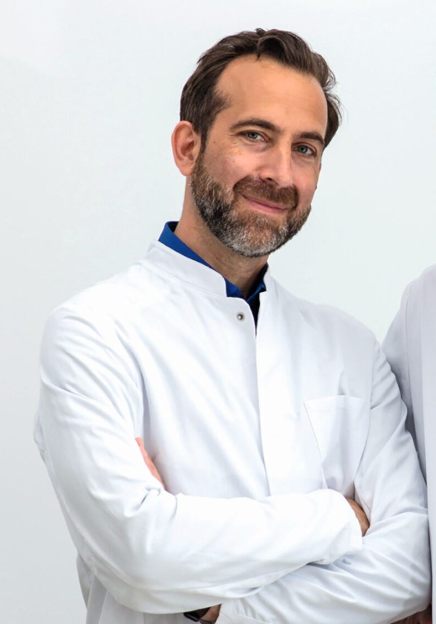Other Treatment Methods

Presbyopia
The ability to see both very close and far away objects clearly in young age with normal vision is due to the eye lens being elastic and being able to adjust to different distances. However, this elasticity decreases with advancing age more and more. By the age of 40 to 50, it becomes difficult to perceive objects clearly that are at a usual reading distance. When patients notice this, it is a typical sign of presbyopia.
The elasticity of the lens cannot be preserved or restored with current means. Therefore, many people initially resort to reading glasses in order to read or see clearly at close range. Since the lens of the eye becomes increasingly inflexible, the prescription of the glasses must be regularly adjusted. Another alternative is progressive lenses. However, they are not favored by many patients and have caused many falls on stairs or bring craftsmen, who have to work overhead, to despair.
Presbyopia - away from reading glasses
However, today presbyopia can be corrected at any time with laser or lens treatments and achieve high independence from glasses. For the treatment or correction of presbyopia, there are various options available. As with any elective procedure, the risk profile should be the top priority when choosing the method because presbyopia is not a disease, it's primarily about improving the quality of life of patients with the aim of achieving independence from reading or progressive lenses.
If, after a thorough preliminary examination, it is determined that the patient's eye lens is still clear and there is nothing else against eye laser correction, then eye laser treatment rather than a refractive lens replacement should be advised. Comparing the risk profile of laser eye procedures with lens operations, the safety of laser eye procedures is higher and the complication risk lower. Laser eye treatment is scientifically proven to be safer than wearing contact lenses. Also completely painless. These facts are known to few.
The overlay vision is the clearly "more tolerable" version of presbyopia correction.
Presbyond – Laser eye surgery based on the principle of overlay vision
Overlay vision laser eye surgery is a treatment in which the eyes are set to different distances using different optical principles. Additionally, a special ablation profile in both eyes leads to an increase in spherical aberrations, resulting in greater depth of field without affecting contrast vision. The combination of slight undercorrection and increased depth of field enables good vision at near, far, and intermediate distances. Because both eyes differ by 1.5 D, it usually requires a neural adaptation phase of about one to three months. Due to the increased depth of field, neural adaptation to two different diopter values of both eyes is easier and is usually very well tolerated by patients.
PresbyMAX
An alternative to the Presbyond laser treatment is the treatment spectrum with the excimer laser. The PresbyMAX principle creates bi-aspherical, multifocal ablation profiles on both eyes. This is achieved by optimizing each eye in the central area for near and in the peripheral area for distance. Here too, an overlay vision is sought, the dominant eye is corrected to 0.00 D and the non-dominant eye to near with about -1.5 D. This allows good vision at all distances but also often requires neural adaptation of one to three months.
PRESBY EDOF DUS formula eye laser treatment
The PRESBY EDOF DUS formula eye laser treatment is a combination of PRESBYOND and PRESBYMAX to provide presbyopic patients with as consistent vision as possible from distance to intermediate distance to reading, regardless of whether they were previously farsighted, emmetropic, astigmatic or nearsighted. In short, an eye laser correction that simultaneously corrects both reading and distance glasses. And it's completely painless during and after the surgery within seconds for both eyes.
How can we know that this procedure works well?
Numerous national and international ophthalmologists, including Dr. Breyer from the premium clinic in Düsseldorf have undergone this treatment themselves.
What safety does this laser procedure offer?
If the near addition is perceived as too high postoperatively or is not tolerated, it can be partially or even completely reverted by laser, which is unique.
Gentle eye laser treatment according to the principle of monovision
An alternative treatment method for presbyopia is monovision with the Trans PRK, SMILE, or Lasik procedure. Here, one eye is optimized for good near vision, while the other eye is optimized for distance vision. vision at a distance In this way, good visual quality is achieved both near up to PC distance and in the distance. Only at intermediate distances do both eyes see slightly blurry. This can make it harder for the brain to merge both images, and getting used to it takes longer. This visual impression is not suitable for everyone, which is why it must be clarified in advance during a patient conversation who is a suitable candidate for it.
Implantable contact lenses
Implantable contact lenses (ICL), which are inserted into the posterior chamber, are suitable not only for younger patients to correct nearsightedness, farsightedness, and astigmatism They are also available with a multifocal optic (Implantable phakic contact lenses – IPCL or EVO VIVA®). This makes these lenses an interesting alternative for presbyopic patients whose natural lens is still clear and who want to live independently of reading or progressive glasses. Should a cataract later develop, this lens can be removed at any time and replaced with a multifocal lens.
Refractive lens exchange
Only at the beginning Cataract In cases of extreme values and medical indication, an early cataract operation should be performed, which in this case is referred to as a refractive lens exchange. In this operation, the interior of the natural lens is removed, and a premium lens with extended depth of focus (EDOF) or a multifocal lens is implanted into the natural capsule. Compared to pure laser treatments, this method is a larger intervention and is now also offered with the laser-assisted operation method to demonstrably reduce greater risks.
In summary, it can be stated that laser presbyopia correction offers many advantages. All laser options have a low risk profile, provide excellent visual outcomes without halo and glare symptoms, and are often reversible. Moreover, the procedure is comfortable, quick, and painless for the patient, and over the long term, significantly cheaper than glasses or contact lenses.
Experts for this Treatment Method

- Modern Ophthalmology
Dr. Mirka R. Höltzermann
Augenpraxis Dr. Höltzermann, Dr. von Schnakenburg, Augenpraxis Dres. Höltzermann & von Schnakenburg
- Modern Ophthalmology
Dr. med. Ilya Kotomin
Smile Eyes Leipzig
- Modern Ophthalmology
Priv.-Doz. Dr. med. Daniel Pilger
Smile Eyes Berlin
- Modern Ophthalmology
Prof. Dr. med. Tanja M. Radsilber
Augenzentrum Prof. Dr. med. Holzer & Prof. Dr. med. Rabsilber
- Modern Ophthalmology
Dr. med. Karsten Klabe
Breyer, Kaymak & Klabe Augenchirurgie
- Modern Ophthalmology
Prof. Dr. med. Hakan Kaymak
Breyer, Kaymak & Klabe AugenchirurgieAll Experts in this Department
Show All
- Modern Ophthalmology
Dr. Mirka R. Höltzermann
Augenpraxis Dr. Höltzermann, Dr. von Schnakenburg, Augenpraxis Dres. Höltzermann & von Schnakenburg
- Modern Ophthalmology
Dr. med. Ilya Kotomin
Smile Eyes Leipzig
- Modern Ophthalmology
Priv.-Doz. Dr. med. Daniel Pilger
Smile Eyes Berlin
- Modern Ophthalmology
Raphael Neuhann (FEBO)
Opthalmologikum Dr. Neuhann / Augentagesklinik am Marienplatz
- Modern Ophthalmology
Dr. med. Tabitha Neuhann
Opthalmologikum Dr. Neuhann / Augentagesklinik am Marienplatz
- Modern Ophthalmology









